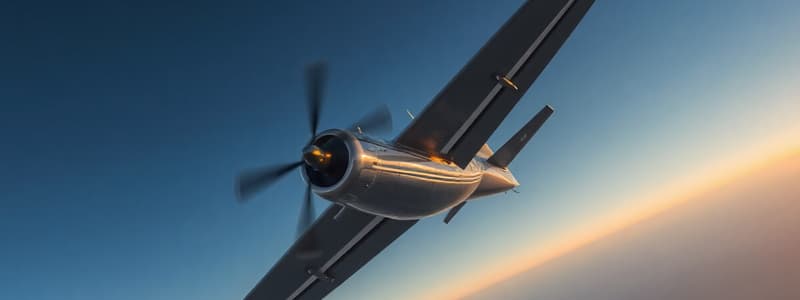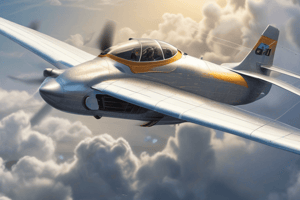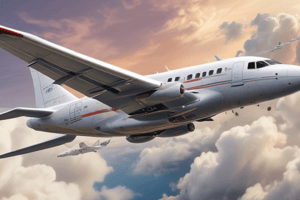Podcast
Questions and Answers
What are the four fundamental forces acting on an aircraft during flight?
What are the four fundamental forces acting on an aircraft during flight?
- Lift, Weight, Torque, Friction
- Thrust, Gravity, Drag, Lateral Forces
- Lift, Weight, Drag, Thrust (correct)
- Lift, Load, Thrust, Drag
How does the center of gravity impact flight performance and stability?
How does the center of gravity impact flight performance and stability?
- An aft center of gravity improves lift.
- A forward center of gravity decreases stability.
- It has no effect on performance or stability.
- A forward center of gravity enhances stability. (correct)
What is the term for the angle at which an aircraft maintains a glide?
What is the term for the angle at which an aircraft maintains a glide?
- Climb Angle
- Approach Angle
- Descent Angle
- Glide Angle (correct)
What is the effect of drag on the glide ratio of an aircraft?
What is the effect of drag on the glide ratio of an aircraft?
Which of the following factors contributes to an imbalanced center of gravity?
Which of the following factors contributes to an imbalanced center of gravity?
What is the glide ratio?
What is the glide ratio?
What effect does stall speed have on the center of gravity?
What effect does stall speed have on the center of gravity?
Which factors specifically impact the still air sink rate of a glider?
Which factors specifically impact the still air sink rate of a glider?
What determines the minimum sink speed for a glider?
What determines the minimum sink speed for a glider?
How can the best glide speed be identified from a glide polar graph?
How can the best glide speed be identified from a glide polar graph?
What effect does adding water ballast to a glider have?
What effect does adding water ballast to a glider have?
What does a higher lift-to-drag (L/D) ratio indicate about the glide angle?
What does a higher lift-to-drag (L/D) ratio indicate about the glide angle?
In still air, at what speed should a glider be flown to minimize height loss during a flight?
In still air, at what speed should a glider be flown to minimize height loss during a flight?
What effect does increasing the weight of a glider have on its performance in thermals?
What effect does increasing the weight of a glider have on its performance in thermals?
What is another term for the best glide speed?
What is another term for the best glide speed?
Which statement is true regarding the glide ratio of a CP-1 glider?
Which statement is true regarding the glide ratio of a CP-1 glider?
What is the significance of the ratio (L/D)max in a power-off glide?
What is the significance of the ratio (L/D)max in a power-off glide?
In a balanced turn, what is true about the lift vector?
In a balanced turn, what is true about the lift vector?
What happens to the altitude during a level coordinated turn?
What happens to the altitude during a level coordinated turn?
Which statement regarding the load factor is correct?
Which statement regarding the load factor is correct?
Which factor affects the turning radius of an aircraft?
Which factor affects the turning radius of an aircraft?
What occurs when the lift in a level turn does not equal the weight of the aircraft?
What occurs when the lift in a level turn does not equal the weight of the aircraft?
In the context of turning flight, what does radial acceleration refer to?
In the context of turning flight, what does radial acceleration refer to?
What defines a coordinated turn?
What defines a coordinated turn?
What does the term 'Load Factor' refer to in the context of flight?
What does the term 'Load Factor' refer to in the context of flight?
Which factor primarily influences the stall speed of an aircraft?
Which factor primarily influences the stall speed of an aircraft?
In a V-n diagram, the maneuver point is characterized by which two conditions?
In a V-n diagram, the maneuver point is characterized by which two conditions?
What is the main limiting factor for high-speed flight as shown in the V-n diagram?
What is the main limiting factor for high-speed flight as shown in the V-n diagram?
What is indicated by the term 'Corner Velocity' in flight dynamics?
What is indicated by the term 'Corner Velocity' in flight dynamics?
What does the 'g' limit refer to in aviation?
What does the 'g' limit refer to in aviation?
During a turn, as the angle of bank increases, what happens to the load factor?
During a turn, as the angle of bank increases, what happens to the load factor?
How can an aircraft survive high G forces during maneuvers?
How can an aircraft survive high G forces during maneuvers?
Flashcards
What are the four forces of flight?
What are the four forces of flight?
The four forces that act on an aircraft in flight - Lift, Weight, Thrust, and Drag.
What is Drag?
What is Drag?
The force that opposes the motion of an aircraft through the air. It is caused by friction between the air and the aircraft's surfaces.
What is Lift?
What is Lift?
The force that acts against the weight of the aircraft. It is generated by the shape of the wings and the movement of the air over them.
What is the Center of Gravity (CG)?
What is the Center of Gravity (CG)?
Signup and view all the flashcards
What happens when the Center of Gravity moves forward?
What happens when the Center of Gravity moves forward?
Signup and view all the flashcards
What happens when the Center of Gravity moves aft?
What happens when the Center of Gravity moves aft?
Signup and view all the flashcards
How does CG affect Stall Speed?
How does CG affect Stall Speed?
Signup and view all the flashcards
What is a Glide Ratio?
What is a Glide Ratio?
Signup and view all the flashcards
Minimum Sink Speed
Minimum Sink Speed
Signup and view all the flashcards
Best Glide Speed
Best Glide Speed
Signup and view all the flashcards
Lift-to-Drag Ratio (L/D)
Lift-to-Drag Ratio (L/D)
Signup and view all the flashcards
Glide Angle (θ)
Glide Angle (θ)
Signup and view all the flashcards
Glide Polar
Glide Polar
Signup and view all the flashcards
Effect of Weight on Glide Polar
Effect of Weight on Glide Polar
Signup and view all the flashcards
Forces in Power-off Glide
Forces in Power-off Glide
Signup and view all the flashcards
Relationship between L/D and Glide Angle
Relationship between L/D and Glide Angle
Signup and view all the flashcards
What is minimum glide angle?
What is minimum glide angle?
Signup and view all the flashcards
What is maximum glide range?
What is maximum glide range?
Signup and view all the flashcards
What is centrifugal force?
What is centrifugal force?
Signup and view all the flashcards
What is centripetal force?
What is centripetal force?
Signup and view all the flashcards
What is an aircraft turn?
What is an aircraft turn?
Signup and view all the flashcards
What is turning flight?
What is turning flight?
Signup and view all the flashcards
What is sideslip?
What is sideslip?
Signup and view all the flashcards
What is skidding?
What is skidding?
Signup and view all the flashcards
Wing Loading
Wing Loading
Signup and view all the flashcards
Load Factor
Load Factor
Signup and view all the flashcards
Load Factor in a Turn
Load Factor in a Turn
Signup and view all the flashcards
Load Factor and Angle of Bank
Load Factor and Angle of Bank
Signup and view all the flashcards
Stalling Speed and Wing Loading
Stalling Speed and Wing Loading
Signup and view all the flashcards
g Limit
g Limit
Signup and view all the flashcards
V-n Diagram
V-n Diagram
Signup and view all the flashcards
Maneuver Point
Maneuver Point
Signup and view all the flashcards
Study Notes
Theory of Flight
- The four forces acting on an airplane are thrust, lift, weight, and drag.
- Thrust is the forward force propelling the aircraft.
- Lift is the upward force opposing weight, created by airflow over and under the wings.
- Weight is the downward force due to gravity.
- Drag is the backward force opposing thrust, reducing speed.
Introduction
- Students will be able to describe the relationship between lift, weight, thrust, and drag; glide ratio; steady state flight and performance; theory of the turn; load factor and its influence on stalling; flight envelope and structural limitations; and methods of lift augmentation.
Four Forces of Flight
- Lift is the upward force created by airflow over and under the wings.
- Weight is the force pulling the aircraft downwards due to gravity.
- Thrust is the forward force propelling the aircraft through the air.
- Drag is the backward force that opposes thrust.
Vectors
- Arrows showing forces acting on an airplane are called vectors.
- The length of the arrow indicates the magnitude of the force.
- The direction of the arrow indicates the direction of the force.
- Multiple forces acting simultaneously combine to create a resultant force.
Lift
- Lift is the key aerodynamic force that opposes weight.
- Air flowing over and under the wings creates a pressure differential.
- This difference in pressure generates lift.
Weight
- Weight is a force caused by gravity acting on the mass of the aircraft.
- Center of Gravity (CG) is the point where the entire weight of the aircraft is considered concentrated.
- CG has a definite relationship with lift.
Centre of Gravity
- CG is the point within an aircraft where the weight acts.
- It is determined by the general design of the aircraft.
- The designer determines how far the center of pressure will travel.
- CG is placed in front of the center of pressure for correct flight speed.
- This provides restoring moment for flight equilibrium.
Adverse Forward Center of Gravity
- When too much weight is towards the front of the aircraft, the CG is shifted forward.
- Possible flight conditions include: increased tendency to dive, increased difficulty in raising the nose during landing, increased oscillation tendency, increased danger during flap operation, development of dangerous spin characteristics.
Adverse Rear Center of Gravity
- When too much weight is toward the tail of the aircraft, the CG is shifted aft.
- Possible flight conditions include: decreased flying speed, decreased range, increased danger of stall, dangerous spin characteristics, poor stability, and extreme shifts in CG, leading to an accident.
Effect of Stall Speed on Centre of Gravity
- Airspeed and sink rate must both be in the same units.
- Minimum sink speed is the airspeed at which the glider loses altitude at the lowest rate.
Aircraft Glide Ratio
- Glide ratio is the number of horizontal feet a glider travels in still air for every vertical foot it loses.
- This ratio varies with airspeed, as drag varies with airspeed.
- A glide polar is a graph for this relationship, showing a minimum sink rate at a particular airspeed.
Glider Fly
- Gliding flight occurs when thrust is removed from the four forces.
- Lift, drag, and weight must be in equilibrium for a steady glide.
- The angle of attack (AofA) is crucial for maximum lift/drag ratio and a steady glide.
Equations of Motion for Power-Off Glide
- These equations describe the relationship between drag, lift, and weight during a glide, using variables (W-Weight, D-Drag, L - Lift, θ - glide angle).
Aircraft Turn
- Inertia must be overcome for a turn.
- Banking the aircraft tilts the lift direction, generating a horizontal turning component.
- This horizontal component (centripetal force) and lift components are crucial for a turn.
- Maintaining constant altitude requires balanced lift and weight during a level turn.
Sideslip
- Sideslip occurs when the side wind is not coming from ahead of the aircraft.
- If the bank is too great, a sideways force due to gravity will cause a skid.
Skidding
- Skidding is caused by an insufficient bank angle or when a pilot does not correct for centrifugal force.
- The wind will feel like it is coming from the outside of the turning plane.
Sideway Landing
- Sideway landing is typical for crosswind conditions.
Cross Wind Landing
- This is typical for when the wind is landing at an angle.
Balanced Turn
- The pilot does not feel any sideways forces during a balanced turn.
Turning Flight and The V-n Diagram
- A table shows that with no turn, no change in altitude happens, but with a turn there is either an increase or a decrease in altitude.
Level Turn (Coordinated Turn)
- The lift is inclined at a bank angle ($ \phi $) to the vertical.
- The vertical component of the lift exactly balances the weight. (L Cos $ \phi $) = W
- Resultant force (F,)= √ L2 – W2 or F, = L sin $ \phi $
Load Factor
- The load factor is the ratio between lift and weight(L/W).
- Aircraft have load factor limits (5g, for example) for which structural damage may occur.
Load Factor During a Turn
- Lift increases significantly during turns.
- Lift bracing (struts, spars) is required to handle increased loads during turns.
Load Factor Angle of Bank
- The stalling speed is calculated mathematically using the formula W/L = cos e, and L=W/cos e.
- The factors are lift (L), weight (W), and angle of bank (e).
- Stall and maneuvering speed are calculated using these.
- Different values of the bank angle (e.g., 60, 70.5, 75.5, 80.25 degrees) for a given stalling speed can provide values of turning lift.
Wing Loading
- Wing loading is the aircraft's weight divided by the wing area.
- Weight compared to wing area governs the minimum speed.
- Lower Wing loading = lower minimum speed
- Higher Wing loading = higher minimum speed
Wing Loading Stalling Speed
- Lower wing loading = lower stalling speed
- Higher wing loading = higher stalling speed
- Adding weight to the aircraft increases wing loading, minimum speed, and stalling speed.
"g" Limit
- "g" limit is an aircraft's ability to withstand structural stress during turns
- High g-forces lead to structural damage
How to survive high G force?
- High G suits might be needed.
"g" Limit from V-n diagram
- The V-n diagram displays the relationship between airspeed and load factor for various flight conditions.
V-n diagram (Low Speed)
- This diagram shows how stall limits and structural limits affect the maximum load factor, along with speed.
V-n diagram (High Speed)
- The maximum load factor is limited by the aircraft's structural designs.
Maneuver point
- The maneuver point is a point on the curve where the load factor and speed are highest and where the maximum aerodynamic lift and load factor are realized, before stall or structural failure.
Corner velocity (v*)
- The corner velocity is the speed at which the aircraft achieves its maximum turn rate.
V-n diagram (Low speed) and V-n diagram (High speed)
- Stall limits and structural limits affect maximum load factors and speeds.
Additional notes:
- Figures and diagrams will greatly aid understanding.
Studying That Suits You
Use AI to generate personalized quizzes and flashcards to suit your learning preferences.




